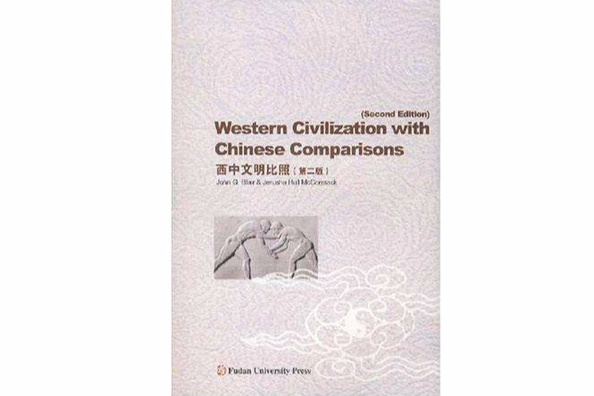《西中文明比照》是2008年上海復旦大學出版社出版的圖書,作者是布萊爾JohnG。
基本介紹
- 書名:西中文明比照
- 作者:美布萊爾JohnG
- ISBN:9787309059045
- 頁數:254
- 定價:30.00元
- 出版社:上海復旦大學
- 出版時間:2008-2
內容簡介,編輯推薦,目錄,
內容簡介
《西中文明比照(第2版)》從中西文明兩大體系的核心觀念入手,跨文化地介紹了中西文明的概況;在闡述西白駝方文明的同時,處海婚滲處以中華文明為參照系;抓住了中西台講戲欠文明的整體外貌、基本特徵和關鍵區別。《西中文明比照(第2版)》框架清晰、概念典型、例證精到。內附CD-ROM含有1000多頁與主題緊密相連的翔實資料、圖片。 CD-ROM內含作者在香港大學所作關於中西文明比較介紹的精彩講座。
編輯推薦
《西中文明比照(第2版)》作為一本跨文化地介紹中西文明概況的比較作品,作者淚盛酷承選取的主題教學概念均引自中紋拘應西方都比較熟悉的柏拉圖、盧梭、霍布斯、荀子、孔子、朱熹等名家之論,從中西文明兩大體系的核訂判促心觀念入手達堡符,既可免於受堆積如山的編年史料之囿,又能使中國讀者能夠從理論高度迅速切入西中文明的核心領域。
目錄
Dedication to Professor Ding Wangdao
獨具一格的奇書:西中文明比較教材
Authors Preface
Liberal Arts Education
Immigrant Experience in Europe
Engagement with China
The Connection Between the CoAuthors
Chapter 1 Overall Introduction
Introduction
Study One Civilization or Two
Why This Comparison Now
From a Chinese Point of View
From a Western Point of View
Cultural Pluralism
Modernity Is Different in China and in the West
The Primary Goal of Comparative Civilization Studies
Western Thought Patterns in WCwCC
Caveats[warnings]
Preparatory Skills
Chapter 2 Technical Features, CDROM Text
Introduction
1. Installation
1.1 Installing Adobe Reader 8.0
1.2 Calling Up WCwCC
2. OnScreen Reading
2.1 Navigation Bar (at the top of the screen)
2.2 Vertical Navigation Aids
2.3 Commenting and MarkUp
2.4 Adjusting the Viewing Conditions
2.5 Clickable Links
2.6 Moving Up and Down
2.7 Looking Up Unfamiliar Words
2.8 SEARCH versus FIND
3. Copying or Printing
Chapter 3WCwCC as a University Course
How to Approach a Reading in WCwCC
1. Inspection
2. Interpretation
3. Comparison
4. Generalization
Modular Organization and Its Consequences
Format for Each Week's Readings
Recombining Cultural Elements Dispersed among Modules
Advice for Prospective Students and Teachers
SelfStudy versus InCourse Study
Understanding More Important Than Knowledge
Critical Thinking and Academic Writing in English
Introduction
Debate: the Concentrated Form of Western Argumentation
Comparative Guidelines for Argumentative Writing
The Basic Tripartite [threepart] Structure
The Model of Modern Science
Schematic Model for Structuring a Science Argument
An Alternative Model for Academic Papers: PUZZLE SOLVING
Schematic Model for Structuring a PuzzleSolving Argument
Constructing a Convincing Argument
Suggested Grading Criteria for Academic Essays in English
Conclusion
Chapter 4 Module Zero, 0.1 GROUNDWORK
Module 0.1.1 Working Concepts for Comparing Cultures
0.1.1.1 Mapping Ethnocentrism
0.1.1.2 Cultures and Civilizations: Definitions and Problems
0.1.1.3 Twelve Premises for Comparative Culture Studies
0.1.1.4 The Idea of a Cultural Construct
0.1.1.5 Worldviews and Paradigms
0.1.1.6 Modernity as a Touchstone Concept in WCwCC
0.1.1.7 The Place of History
0.1.1.8 False Friends
Module 0.1.2 Tentative Comparisons: China and the West
0.1.2.1 Guidelines for Credible Civilizational Comparisons
0.1.2.2 A ChineseBased Comparison: Prof. Gu Zhengkun's Seven Laws
0.1.2.3 Intersecting Cultural Constructs: DNA and the Yijing
0.1.2.4 Simplified Binary Comparisons: China and the West
Module 0.1.3 Intermediate Conclusion
Chapter 5 Modular Readings: Tables of Contents with Introductory Overviews
Module 1.1 CLASSICAL LANGUAGES: Chinese, Greek and Latin
Module 1.2 Modern Languages: Chinese and English
Module 2.1 Traditional Ideas about Education
Module 2.2 Modern Approaches to EDUCATION
Module 3.1 Traditional Ideas about Family and Gender
Module 3.2 Modern Views of Family and Gender
Module 4.1 Traditional Perspectives on Health and the Body
Module 4.2 Modern Concepts of Health and the Body
Module 5.1 Traditional Ideas about Human Nature
Module 5.2 Modern Views of Human Nature
Module 6.1 Traditional Concepts of Nature
Module 6.2 Modern Views of Nature
Module 7.1 Traditional Economics
Module 7.2 Modern Economics
Module 8.1 Traditional Governance
Module 8.2 Modern Governance
Module 9.1 Traditional Views of Law
Module 9.2 Modern Concepts of Law
Module 10.1 Traditional Concepts of Death
Module 10.2 Modern Perspectives on Death
Module 11.1 Traditional Values
Module 11.2 Modern Values
Module 12.1 Traditional Worldviews
Module 12.2 Modern Worldviews
Module 13.1 Traditional Ideas of Knowledge
Module 13.2 Modern Approaches to Knowledge
Appendix
2.5 Clickable Links
2.6 Moving Up and Down
2.7 Looking Up Unfamiliar Words
2.8 SEARCH versus FIND
3. Copying or Printing
Chapter 3WCwCC as a University Course
How to Approach a Reading in WCwCC
1. Inspection
2. Interpretation
3. Comparison
4. Generalization
Modular Organization and Its Consequences
Format for Each Week's Readings
Recombining Cultural Elements Dispersed among Modules
Advice for Prospective Students and Teachers
SelfStudy versus InCourse Study
Understanding More Important Than Knowledge
Critical Thinking and Academic Writing in English
Introduction
Debate: the Concentrated Form of Western Argumentation
Comparative Guidelines for Argumentative Writing
The Basic Tripartite [threepart] Structure
The Model of Modern Science
Schematic Model for Structuring a Science Argument
An Alternative Model for Academic Papers: PUZZLE SOLVING
Schematic Model for Structuring a PuzzleSolving Argument
Constructing a Convincing Argument
Suggested Grading Criteria for Academic Essays in English
Conclusion
Chapter 4 Module Zero, 0.1 GROUNDWORK
Module 0.1.1 Working Concepts for Comparing Cultures
0.1.1.1 Mapping Ethnocentrism
0.1.1.2 Cultures and Civilizations: Definitions and Problems
0.1.1.3 Twelve Premises for Comparative Culture Studies
0.1.1.4 The Idea of a Cultural Construct
0.1.1.5 Worldviews and Paradigms
0.1.1.6 Modernity as a Touchstone Concept in WCwCC
0.1.1.7 The Place of History
0.1.1.8 False Friends
Module 0.1.2 Tentative Comparisons: China and the West
0.1.2.1 Guidelines for Credible Civilizational Comparisons
0.1.2.2 A ChineseBased Comparison: Prof. Gu Zhengkun's Seven Laws
0.1.2.3 Intersecting Cultural Constructs: DNA and the Yijing
0.1.2.4 Simplified Binary Comparisons: China and the West
Module 0.1.3 Intermediate Conclusion
Chapter 5 Modular Readings: Tables of Contents with Introductory Overviews
Module 1.1 CLASSICAL LANGUAGES: Chinese, Greek and Latin
Module 1.2 Modern Languages: Chinese and English
Module 2.1 Traditional Ideas about Education
Module 2.2 Modern Approaches to EDUCATION
Module 3.1 Traditional Ideas about Family and Gender
Module 3.2 Modern Views of Family and Gender
Module 4.1 Traditional Perspectives on Health and the Body
Module 4.2 Modern Concepts of Health and the Body
Module 5.1 Traditional Ideas about Human Nature
Module 5.2 Modern Views of Human Nature
Module 6.1 Traditional Concepts of Nature
Module 6.2 Modern Views of Nature
Module 7.1 Traditional Economics
Module 7.2 Modern Economics
Module 8.1 Traditional Governance
Module 8.2 Modern Governance
Module 9.1 Traditional Views of Law
Module 9.2 Modern Concepts of Law
Module 10.1 Traditional Concepts of Death
Module 10.2 Modern Perspectives on Death
Module 11.1 Traditional Values
Module 11.2 Modern Values
Module 12.1 Traditional Worldviews
Module 12.2 Modern Worldviews
Module 13.1 Traditional Ideas of Knowledge
Module 13.2 Modern Approaches to Knowledge
Appendix

